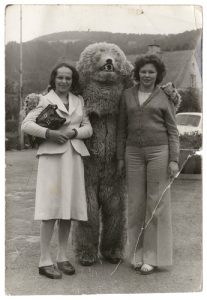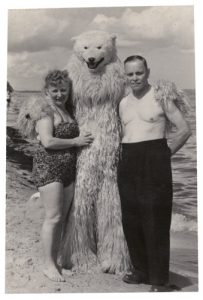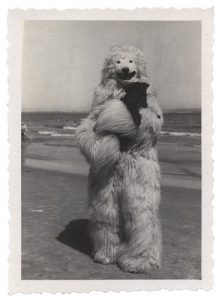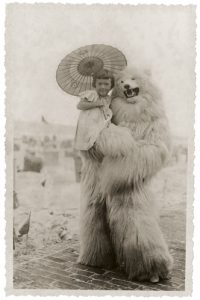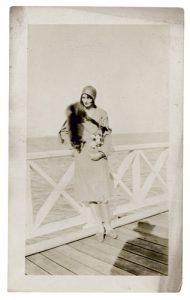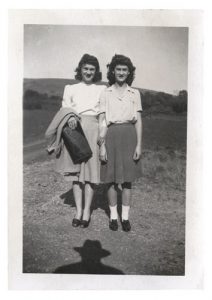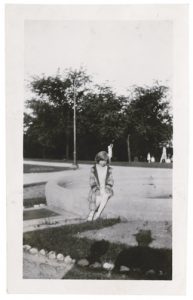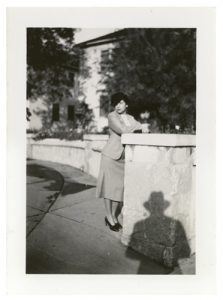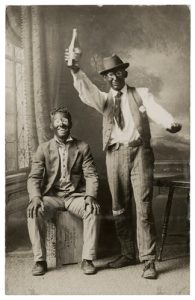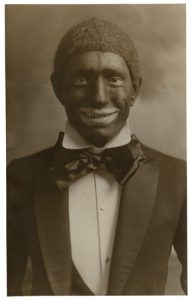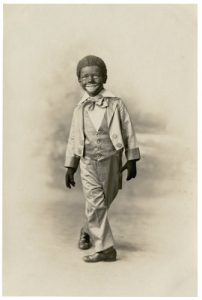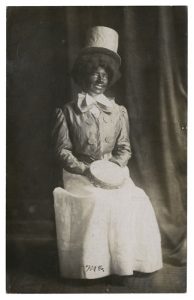Photography Never Dies
History and future of photographic medium
/Histoire et futur du medium photographique
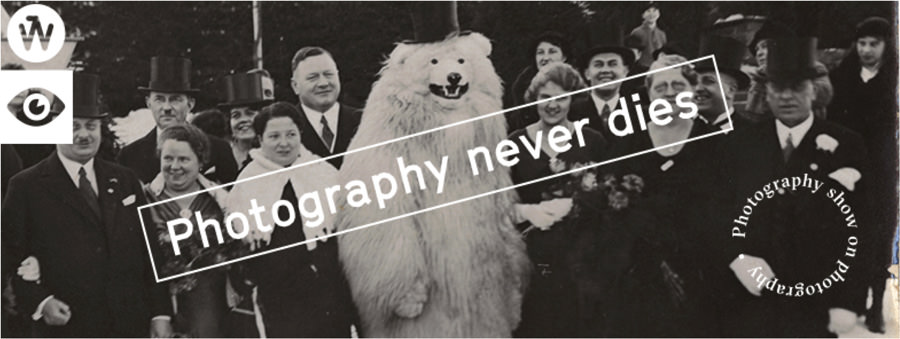
Exposition de trois séries de la Collection Jean-Marie Donat – 17 Novembre 2016
Dans le cadre de l’événement Wroclaw 2016, Capitale Européenne de la Culture, l’exposition Photography Never Dies se tiendra à la gare Centrale de Wroclaw de novembre 2016 à janvier 2017. Cette exposition collective interroge sur le passé et le devenir de la photographie en tant que medium. Elle reprend notamment les trois séries de la collection Jean-Marie Donat présentées en 2015 à Arles. Ces trois series – TEDDYBÄR, BLACKFACE et PREDATOR – ont été exposées à la Chapelle de la Charité sous le titre Vernaculaire ! Trois séries de la collection Jean-Marie Donat dans le cadre de la programmation officielle des Rencontres de la Photographie d’Arles 2015. Ces trois séries ont également fait l’objet d’ouvrages en édition limitée à 500 exemplaires numérotés, publiés par les éditions Innocences.
Vernissage : 17 November 2016
Lieu : Gallery at the Main Train Station, ul. Piłsudskiego 105
Date d’exposition : 17 November 2016 – 5 January 2017
Commissaire d’exposition : Krzysztof Candrowicz
Organisateur : Europejska Stolica Kultury Wrocław 2016
Site de l’événement : http://www.wroclaw2016.pl/photography-never-dies.-history-and-future-of-photographic-medium
Facebook de l’événement : https://fr-fr.facebook.com/events/1544501335853608/
***
Présentation de l’exposition
Par l’institution organisatrice
The exhibition is devoted to photography and presents its history form the moment of its inception. Apart from renowned authors and curators such as Erik Kassels or Loretta Lux, the audience will have an opportunity to view archival daguerreotypes, carte de visite which will be presented together with the contemporary amateur photos from Instagram or Flickr. In spite of the exhibition’s tittle statement “Photography never diesâ€, the idea of capturing still images has survived and it is better than ever – photography never dies!
Par le commissaire de l’exposition Krzysztof Candrowicz
THE STORY OF THE PAST AND THE FUTURE OF THE MEDIUM : Photography Never Dies in the exhibition dedicated to photography and its history. It is not an encyclopaedic or historical study but rather a metaphor and an illustrated story about the photographic medium. The presentation consists of photography icons from last 177 years, as well as archive photographs and contemporary amateur photographs from Instagram or Facebook. In addition to works of recognized artists and curators, such as Erik Kessels, Catherine Balet and Francesca Seravalle. Despite the death of photography as we know it, the idea of preserving reality on still images have survived and is flourishing better than ever, because photography never dies.
CHAPTER 1: THE BIRTH OF PHOTOGRAPHY BY FRANCESCA SERAVALLE
CHAPTER 2: THE PATH OF PHOTOGRAPHY BY CATHERINE BALET
CHAPTER 3: THE ICONS OF PHOTOGRAPHY BY JOJAKIM CORTIS & ADRIAN SONDEREGGE
CHAPTER 4: THE PRIVACY OF PHOTOGRAPHY BY JEAN-MARIE DONAT
CHAPTER 5: THE MAN OF PHOTOGRAPHY BY VOLKER HINZ
CHAPTER 6: THE EXPERIENCE OF PHOTOGRAPHY BY ARTUR URBANSKI
CHAPTER 7: THE OPENESS OF PHOTOGRAPHY BY TOM STAYTE
CHAPTER 8: THE IMMORTALITY OF PHOTOGRAPHY BY ERIK KESSELS
***
Présentation des séries exposées de la collection Jean-Marie Donat
(Extraits du catalogue)
INTRODUCTION. The 3 series presented are from a collection of 10,000 photos. One of their distinguishing characteristics is the repetition of a detail, which creates a sense of strangeness that questions the source of feelings. The body of work tells stories to those who know how to listen to them. Jean-Marie Donat is an informed collector of photographs, which he has been gathering, for more than twenty-five years, during his journeys in Europe and the United States. The collection revolves around a powerful idea: providing a singular interpretation of the century. His photographs collection is subject of exhibitions throughout Europe and books in rare limited and unique edition.
« The art of assembly, montage, and juxtaposition assuredly creates connections between those images. The oblique gaze we cast upon them is the true constituent of the grouping that gives them significance, without which those images would remain dispersed, scattered, unknown, uncomprehended. »
Jacinto Lageira, about the Jean-Marie Donat Collection.
BIOGRAPHY. Born in 1962 in Paris, France, Jean-Marie Donat has worked in publishing for thirty years. He contributed to the trendy Italian review ‘Frigidaire’ at the beginning of the 1980s, and was the studio manager and artistic director of Sarbacane Design for fifteen years, and participated in 2003 in launching les éditions Sarbacane. He now manages his own publishing company, AllRight. In 2015, Les Rencontres d’Arles is an occasion for him to launch Innocences, a publishing house dedicated to images of all kinds.
 TEDDYBAR. These intriguing snapshots were taken by street photographers between the end of the First World War and the late 1960s. These prints were discovered by collector Jean-Marie Donat in various regions of Germany. Anonymous models pose next to placid, playful, sometimes disturbing polar bears: these bears traverse the decades, unchanged. The history of Germany unfolds.
TEDDYBAR. These intriguing snapshots were taken by street photographers between the end of the First World War and the late 1960s. These prints were discovered by collector Jean-Marie Donat in various regions of Germany. Anonymous models pose next to placid, playful, sometimes disturbing polar bears: these bears traverse the decades, unchanged. The history of Germany unfolds.
« It is difference that intrigues us. More than multiplication, it is the multiplicity of bears and clients that holds the attention. […] we find, in this low art corpus, elements of the most sophisticated high art image structuring. Beyond the type of bear, the relationships formed during the shot, and rare, unexpected framings, it is our own perception of these photographs that must be examined. What does our spontaneous way of looking at these images teach us about our gaze? In short, this is an opportunity to perform an analysis, rudimentary as it may be, of how we see. »
By Klaus Peter Speidel, artist and philosopher.
PREDATOR. These photographs were taken in the 1920s through the 1970s, throughout the world. They have one detail in common, which reminds us of the history of amateur photography: the shadow of the photographer. Donat appropriated this incongruity, choosing only images in which the shadow appears wearing a hat. The effect of repetition created by imagining this series becomes its subject: the same man looms, always and everywhere.
« As a similar shadow reappears in multiple photographs, this familiar apparition becomes, in fact, a familiar: strange, bizarre, disturbing, what is known in German as disturbing strangeness (Unheimlich), a non-familiar that nonetheless presents a familiar face, homely yet eldritch, an other that is still, somehow, known. […] We are thus given access to a sort of view from nowhere, as though the shadow were engendered naturally without the assistance of instrument or technique. This third gaze is found there, somewhere, in the shadow of its shadow. »
By Jacinto Lageira, Professor of aesthetics a Paris-Sorbonne and art critic.
BLACKFACE. These photographs were taken in the United States between 1880 and the late 1960s. Some of them promote troupes of travelling performers: the minstrel shows in which whites made up as blacks incarnated, in musical numbers, the « good coloured folkâ†whose music Americans particularly appreciated. Other pictures are souvenirs from private parties, birthdays, or carnivals.
« To put on the face of the other is a primitive ritual that may release primitive emotions. M. Donat’s photographs take us to the dark side of reality, the mysterious side of ourselves, filled with desire to know who we are and to feel more deeply our hallucinatory reality, our pathetic delirium. But the racial dimension of being another is something beyond the scope of what we can grasp unless we accept that skin is merely a covering of a person’s soul, and that ultimately we are all the same. »
By Robert C. Morgan, art critic, professor at the School of Visual Arts, New York.

